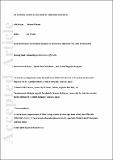Por favor, use este identificador para citar o enlazar a este item:
http://hdl.handle.net/10261/183282COMPARTIR / EXPORTAR:
 SHARE SHARE
 CORE
BASE CORE
BASE
|
|
| Visualizar otros formatos: MARC | Dublin Core | RDF | ORE | MODS | METS | DIDL | DATACITE | |

| Título: | Seed germination and seedling allogamy in Rosmarinus officinalis: the costs of inbreeding |
Autor: | García-Fayos, P. CSIC ORCID ; Castellanos, María Clara CSIC ORCID; Segarra-Moragues, José G. CSIC ORCID | Palabras clave: | Allogamy Geitonogamy Male‐sterile flowers Pollination Reproductive biology Seed germination |
Fecha de publicación: | may-2018 | Editor: | John Wiley & Sons | Citación: | Plant Biology 20(3): 627-635 (2018) | Resumen: | Self‐pollination by geitonogamy is likely in self‐compatible plants that simultaneously expose a large number of flowers to pollinators. However, progeny of these plants is often highly allogamous. Although mechanisms to increase cross‐pollination have been identified and studied, their relative importance has rarely been addressed simultaneously in plant populations. We used Rosmarinus officinalis to explore factors that influence the probability of self‐fertilisation due to geitonogamy or that purge its consequences, focusing on their effects on seed germination and allogamy rate. We experimentally tested the effect of geitonogamy on the proportion of filled seeds and how it influences germination rate. During two field seasons, we studied how life history and flowering traits of individuals influence seed germination and allogamy rates of their progeny in wild populations at the extremes of the altitudinal range. The traits considered were plant size, population density, duration of the flowering season, number of open flowers, flowering synchrony among individuals within populations and proportion of male‐sterile flowers. We found that most seeds obtained experimentally from self‐pollination were apparently healthy but empty, and that the proportion of filled seeds drove the differences in germination rate between self‐ and cross‐pollination experiments. Plants from wild populations consistently had low germination rate and high rate of allogamy, as determined with microsatellites. Germination rate related positively to the length of the flowering season, flowering synchrony and the ratio of male‐sterile flowers, whereas the rate of allogamous seedlings was positively related only to the ratio of male‐sterile flowers. Rosemary plants purge most of the inbreeding caused by its pollination system by aborting the seeds. This study showed that the rates of seed germination and allogamy of the seedlings depend on a complex combination of factors that vary in space and time. Male sterility of flowers, length of the flowering season and flowering synchrony of individuals within populations all favour high rates of cross‐pollination, therefore increasing germination and allogamy rates. Flowering traits appear to be highly plastic and respond to local and seasonal conditions. | Versión del editor: | http://dx.doi.org/10.1111/plb.12686 | URI: | http://hdl.handle.net/10261/183282 | DOI: | 10.1111/plb.12686 | ISSN: | 1435-8603 | E-ISSN: | 1438-8677 |
| Aparece en las colecciones: | (CIDE) Artículos |
Ficheros en este ítem:
| Fichero | Descripción | Tamaño | Formato | |
|---|---|---|---|---|
| Seed_germination.pdf | 756,5 kB | Adobe PDF |  Visualizar/Abrir |
CORE Recommender
SCOPUSTM
Citations
1
checked on 10-may-2024
WEB OF SCIENCETM
Citations
1
checked on 25-feb-2024
Page view(s)
209
checked on 12-may-2024
Download(s)
323
checked on 12-may-2024
Google ScholarTM
Check
Altmetric
Altmetric
NOTA: Los ítems de Digital.CSIC están protegidos por copyright, con todos los derechos reservados, a menos que se indique lo contrario.
